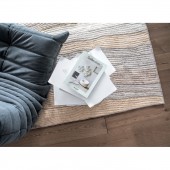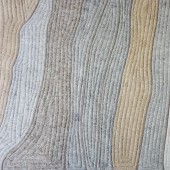
| THE AWARD |
| CATEGORIES |
| REGISTRATION |
| SUBMIT YOUR WORK |
| ENTRY INSTRUCTIONS |
| TERMS & CONDITIONS |
| PUBLICATIONS |
| DATES & FEES |
| METHODOLOGY |
| CONTACT |
| WINNERS |
| PRESS ROOM |
| GET INVOLVED |
| DESIGN PRIZE |
| DESIGN STORE |
| THE AWARD | JURY | CATEGORIES | REGISTRATION | PRESS | WINNERS | PUBLICATIONS | ENTRY INSTRUCTIONS |
Hair of Umay Rug by Marina Begman |
Home > Winners > Design #102374 >Interview |
 |
|
FS: What is the main principle, idea and inspiration behind your design?
MB: Creating Umai's Hair Rug is a complex endeavor, following ancient techniques of shyrdak making. Wool, the primary material, is sheared from sheep in the spring. It is then washed, dried, colored, and pressed into sheets. The sheets are cut into beautiful patterns and stitched together, representing spiritual values and harmony between people and the natural world. These patterns are quilted onto a large piece of plain wool base, creating a soft, thick, high-quality carpet that can last for decades.The shyrdak, a distinctively designed wool rug, is an integral part of the traditional nomadic lifestyle of Central Asia. The technique used to make shyrdaks has been perfected over centuries and passed down from generation to generation. Central Asian nomads use shyrdaks to insulate and decorate their yurts, keeping these moveable homes warm in the winter and cool in the summer. A shyrdak is a highly valuable possession for nomadic people; it’s included in dowries for young brides, and presented as a gift for important life events and celebrations. Design was inspired by a legend of Turkic and Mongolian people, about ancient goddess Umai - a benevolent spirit, the patroness of children and women. The mother goddess was depicted with golden hair, with a comb-shaped hairstyle. The rug drawing is depicting her loose hair in the wind
FS: How long did it take you to design this particular concept?
MB: All design research and sketches took around 3 months
FS: Why did you design this particular concept? Was this design commissioned or did you decide to pursuit an inspiration?
MB: I have always been fascinated by significant role of women in nomadic mythology, where women were treated with great respect and reverence. Unfortunately, in our time, the women are not treated the same in Central Asia. Through this design concept I wanted to remind how important women were for nomadic people
FS: Is your design being produced or used by another company, or do you plan to sell or lease the production rights or do you intent to produce your work yourself?
MB: Currently in production by partner production company
FS: What made you design this particular type of work?
MB: I met Aliya, the founder of Nakta in 2017. She shared how she started a company to preserve nomadic heritage and empower women artisans in rural Kyrgyzstan. The nomadic handmade rugs are at the edge of disappearance, as younger people are moving to the cities and are not learning from their mothers how to make a traditional hand felted rug. Aliya had an idea of reviving this ancient rug making technique through connecting it to the market. Her story inspired me so much and I wanted to make a design for them. When I showed the first sketches, we realized that we think the same way and decided to make the first collection. Thus, our collaboration resulted in «Hair of Umay»rug
FS: Who is the target customer for his design?
MB: Our target customer cares about the story of the product, conscious about the environment and social impact. Our customer is also appreciative of natural sustainable products, interior design, and appreciates hand made fabrics.
FS: How did you come up with the name for this design? What does it mean?
MB: The name was inspired by ancient nomadic goddess Umai - a benevolent spirit, the patroness of children and women.
FS: Which design tools did you use when you were working on this project?
MB: All sketches were made manually, then I used software to obtain exact dimensions for production
FS: What is the role of technology in this particular design?
MB: The role of technology is not crucial for this project, all sketches were made manually, the rug was handmade using an ancient nomadic technique using only water, soap, wool, and herbs. Felted wool sheets were dyed by herbs, and hand stitched together by women artisans.
FS: Is your design influenced by data or analytical research in any way? What kind of research did you conduct for making this design?
MB: The research was two-folds: First, I researched the technique itself. Secondly, I researched the ancient legends of central asian nomads to come up with a new design in shyrdak technique. The technique research included academic research about shyrdak making, traveling to Kyrgyzstan to remote mountainous region Naryn, where this technique is still kept by elder women, interviewing them, as well as participating in shyrdak making to experience and understand the technique firsthand. The research of central asian legends included interviewing the elder women artisans in Naryn, academic research, as well as interviewing a university professor on Kyrgyz literature.
FS: What are some of the challenges you faced during the design/realization of your concept?
MB: The main challenge was to get the right shades to combine when dyeing wool with herbs.
FS: How did you decide to submit your design to an international design competition?
MB: I wanted people in the world to learn more about ancient techniques of rug making in Central Asia and nomadic cultural heritage
FS: What did you learn or how did you improve yourself during the designing of this work?
MB: While working on this project, I learned more about the ancient handmade rug making technique, and improved my communication skills with production company
FS: Thank you for providing us with this opportunity to interview you.
A' Design Award and Competitions grants rights to press members and bloggers to use parts of this interview. This interview is provided as it is; DesignPRWire and A' Design Award and Competitions cannot be held responsible for the answers given by participating designers.
| SOCIAL |
| + Add to Likes / Favorites | Send to My Email | Comment | View Press-Release | Translations |




